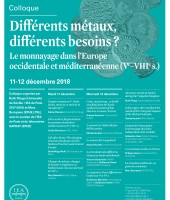Different Metals, Different Needs?
Coinage in Western and Mediterranean Europe (5th–8th centuries)
Conference organized by Ruth Pliego (University of Seville / Paris IAS 2017-2018) and Marc Bompaire (EPHE | PSL), with the support of the Paris IAS and the SAPRAT Laboratory
Presentation
The Germanic kingdoms, as successors of the Roman Empire, were attached to many aspects of the Roman tradition and tried to perpetuate them, and one of the most important was the production of gold and silver coinage as an expression of power and prestige. Numismatic researchers have had at their disposal an important repertoire of precious metal coins from different kingdoms coming from finds and old collections due to the interest and value of these pieces. Nevertheless, besides the high-quality issues in precious metals, the numismatic repertoire of this period also includes small and humble pieces with crude technique and general poor state of preservation which may explain their near-total absence from ancient excavation inventories. Notwithstanding the aforementioned, currently we count with many ensembles of these bronze coins –generally known as minimi–, even the material is in itself problematic, essentially due to the large amount of cleaning and restoring involved, so this material is sent to the ‘back of the queue’ in the priorities of the Museums, which explains why so many of the specimens are reported to feature ineligible legends, this has hampered their analysis and publication.
The different monetary metals do not imply different methods of manufacture but probably a different way of approaching the production of coinage and certainly a different care. However, minting different metals may involve different issuing authorities, and generally and almost certainly involves different social uses and different dispersion of coins. Broadly speaking, we would have different environments of coin circulation that rarely match exactly: the coinage in precious metals, principally in gold, minted for every kingdom and is used principally (but not only) in a ‘regional’ economy of gifts, being, thus, limited in explaining the market economy, and on the other hand, the minimi, minted by diverse authorities unlike the gold and silver coins, circulated all mixed together during the sixth and seventh century, and likely extended beyond that period. The wide circulation of these minimi through the Mediterranean indicates that they played an essential role in the economic life of the period.
This Study Day is focused to show the coin repertoire of the Early Middle Ages in several metals and in the different areas of Europe, and trying to establish a nexus between them up to the first decades of the eight century which leads to important changes, that will be notably accentuated with the sudden Umayyad conquest of the Iberian Peninsula and the rise of the Carolingian Empire.
Program
Tuesday, December 11th
15h00 - 15h30 Opening by Saadi Lahlou, director of the Paris IAS
Presentation of the conference by Marc Bompaire and Ruth Pliego
Session 1 : Le cadre général : point de départ et point de référence
15h30 - 16h00 L’empire romain au Ve siècle : déchu, ruiné ou en train de se transformer ?
Sabine Panzram, Universität Hamburg
16h00 - 16h30 Εntre unité et fragmentation : les systèmes monétaires méditerranéens (Ve-VIIIe siècle)
Cécile Morrisson, AIBL, Paris
16h30 - 17h00 Break
Session 2 : En s’éloignant de la Méditerranée
17h00 - 17h30 Life after Rome: The changing monetary landscape of early Medieval Northern and Central Europe
David Wigg-Wolf, DAI Frankfurt am Main
17h30 - 18h00 Changer de métaux, changer de besoins ? Angleterre, la Méditerranée et la mer du Nord au VIIe siècle
Rory Naismith, King's College London
18h00 - 18h30 General discussion
Wednesday, December 12th
Session 3 : L’Italie : or, argent et bronze, approches politiques, régionales, chronologiques
9h00 - 9h30 Coins, metal scrap... or both?: coin finds from the Early-medieval castrum of San Martino-Lomaso (Trento)
Andrea Saccocci, Università di Udine
9h30 - 10h00 La moneta in Italia alla fine dell'età antica
Michele Asolati, Università di Padova
10h00 - 10h30 Le bronze dans la circulation monétaire de l'Italie ostrogothe et byzantine (VIe-VIIe s.)
Alessia Rovelli, Università di Tuscia
10h30 - 11h00 Break
Session 4 : La Gaule
11h30 - 12h00 La circulation des différents métaux en Gaule méridionale
Vincent Geneviève, INRAP Toulouse / Guillaume Sarah, CNRS IRAMAT Orléans
12h00 - 12h30 Les argentei et leur diffusion en Gaule aux Ve et VIe siècles Guillaume Blanchet, Université de Caen / Guillaume Sarah, CNRS IRAMAT Orléans
12h30 - 13h00 Discussion
13h00 - 14h30 Lunch Break
Session 5 : La Péninsule Ibérique
14h30 - 15h00 Les métaux monétaires de l'Hispania wisigothique : or, argent et bronze
Ruth Pliego, Universidad de Sevilla
15h00 - 15h30 Gold, copper, silver and lead: the metals of the Umayyad conquest of the Iberian Peninsula
Tawfiq Ibrahim, RAH Madrid
15h30 - 16h00 L’argent des Omeyyades : le monnayage des émirs indépendants d’al-Andalus
Sébastien Gasc, Institut National Universitaire Jean-François Champollion, Albi
16h00 - 16h30 Break
16h30 - 17h00 La transition médiévale : en guise de conclusion
Marc Bompaire, EPHE PSL Paris
17h00 - 18h00 Discussion
|
|
|
'Pocket Money'. The Circulation of the Minimi in the Mediterranean Sea in the Early Middle Age 01 October 2017 - 30 June 2018 |
|
|

